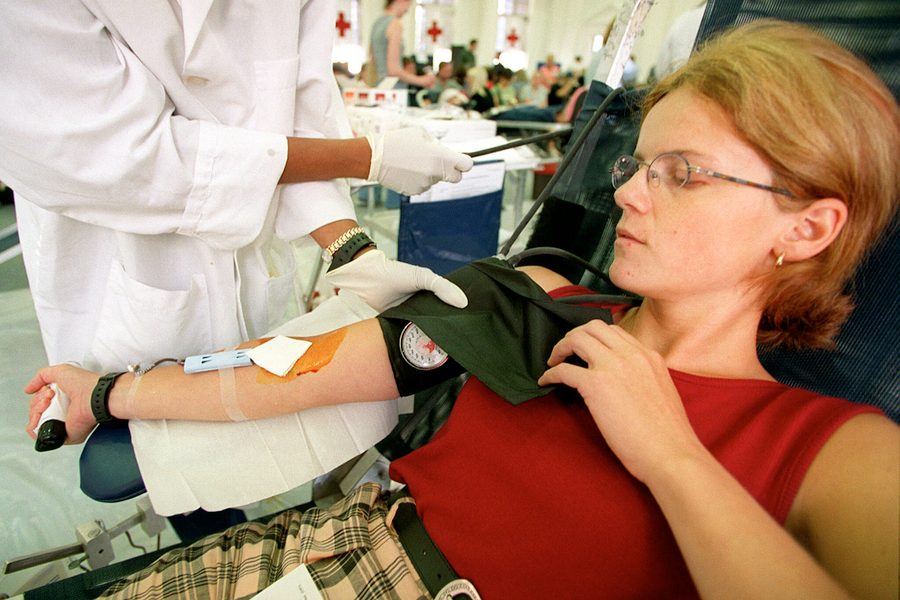
A press release about a labor dispute at the American Red Cross (ARC) is challenging perceptions of the venerable institution and how it conducts its mobile unit blood drives.
Issued in early November by Council 32 of the American Federation of State, County and Municipal Employees (AFSCME), the announcement states:
In recent months, the Red Cross-Badger Hawkeye Region began to require nursing staff to load and drive trucks and truck drivers/loaders to draw donors’ blood. Those who refuse risk the loss of their jobs.
AFSCME also notes that the National Labor Relations Board (NLRB) has “found sufficient grounds” to hear the union’s unfair labor practice complaint on behalf of members subject to the combined and seemingly disparate job duties.
ARC, the complaint asserts, unilaterally imposed the work scheme while “failing and refusing to bargain collectively and in good faith,” which is a violation of the National Labor Relations Act.
AFSCME District Representative Neil Rainford says a ruling on the complaint covering members in Wisconsin and northeast Iowa could impact thousands of workers under a sweeping 2015 “national addendum” between ARC and eight major unions with dozens of local affiliates. Some unions have had regional contracts in place for years.
AFSCME was and is willing to bargain over new classifications with the right protections, Rainford says, but is pushing back as ARC pushes forward with a plan that’s “bad for donors and bad for staff.”
ARC’s job posting for the hybrid Driver/Phlebotomist position has no requirements beyond a high school diploma, people skills and the ability to drive legally and move heavy objects. Rainford says the position pays less than what current nursing staff earn — even as it morphs two jobs into one.
Longtime ARC supporter Ruth Brill tells In These Times she is appalled. Since 1971, Brill says, she has given 20 gallons of blood and served for six years on ARC’s regional blood services board of directors.
“I’ve seen changes from having a doctor at every drive and then nurses, and then it went to phlebotomists, and now it’s going to truck drivers with little training,” Brill says. “This is disrespectful to donors. We shouldn’t have to ask or even know to ask for an experienced person. They should all be qualified.”
For all the exasperation Brill feels, workers interviewed for this article are even more impacted. All are skilled, with as many as 30 years on the job. Unless they prevail at the NLRB or recast themselves in ARC’s mold, they face obsolescence like so many widgets waiting to be replaced by newer, cheaper units. They worry about the risks to themselves and the public.
Speaking on condition of anonymity, the workers quoted here are identified by pseudonyms. AFSCME Council 32 backs up their central claims and allegations, and an AFSCME representative has verified their observations.
Nursing staff to do truck work
Casey, Chris and Rory work out of different ARC bases in the region and are members of the predominately female AFSCME Local 1205. They are among the nurses and phlebotomists whose regular duties include direct donor contact and care.
They meet and greet, ask dozens of questions and perform mini physicals to assess donors’ health. They locate, puncture and draw blood from a suitable vein and extract the needle in a way that prevents dangerous spills.
They use computers that track vital information and run machines that collect life-saving blood. They minister to nervous first-timers and administer any aftercare that’s needed in case, for example, a donor faints.
They do all that and more. They draw the line at loading and driving trucks.
Depending on the size of the blood drive, hundreds to thousands of pounds of equipment and supplies must be moved. “I don’t know how they’d do it,” Casey says of co-workers at her location. “Some of the people here weigh maybe 120 pounds — little, tiny gals. I’m 165, and I couldn’t do it. Somebody’s going to get hurt.”
Long-term staff, some in their 50s, have resisted, but pressure from management is mounting. “Some people say they are being bullied,” Casey adds. “Nobody wants to lose their jobs, but we’re trying to stick up for our rights.”
At Chris’s base, no senior staffer has had to do truck work yet, but the word is out that change is coming. Management hasn’t had much luck in retaining new hires for the hybrid positions. “They’ve hired roughly 10 people,” Chris says, “and only have four left.”
Dispatched to blood drives at schools, arenas and other venues throughout the region, Local 1205 members already put in long days. They often arrive early in the morning, work 8-12 hour shifts, and then return home late at night only to start all over again the next day.
Hours are irregular and can include work on weekends and holidays. Adding driver and loader duties could extend work another two to three hours.
“You can’t focus if you’re too tired,” Chris says. “You’ve got to follow procedures, and, if not, it can really mess up things. It’s happened!”
Chris brands the double-duty experiment with new hires as “trial and error that wasted so much time and money” and has some long-term staff saying they’ll have to leave too.
“We work too hard to have to deal with donors and put on a good face, and we are not going to accept having to do all these other things that are not making anything better,” says Chris. “It’s just making everything worse.”
At a third location, Rory recounts similar problems — not the least of which is the training ARC gives new hires for the hybrid jobs. With staff cutbacks in the education department and implementation of a virtual classroom, Rory says cross-trained workers are “not equipped with skills or knowledge” for the job — and “it shows.”
Rory is fiercely protective of the truck drivers, who are mostly men and mostly members of AFSCME Local 1558. Classified as Mobile Unit Assistants (M.U.A.s), they do the sorting, moving, driving, lifting and other tasks that enable the nursing staff to provide donor services that have been covered by a union contract for 30 years.
“I love our M.U.A.‘s,” Rory says, worried about what will happen to the drivers. “They are being punished for work management took from them and gave to us.”
Truckers to draw blood
Drew, Sean and Morgan know well the rigors of skilled M.U.A. work. It’s hard and physical and requires working outdoors in all kinds of weather.
In sweltering heat, torrential rains or frigid temps with “black ice” roads, M.U.A.‘s, like postal workers, are not deterred from their “appointed rounds“ — and they drive long distances while carrying expensive cargo, precious blood and human beings.
They load, unload and set up sensitive equipment, medical supplies, electrical cables, beds for donor care and whatever else is needed for the blood drive. Stairs, narrow doorways or lack of a loading dock require items to be hand carried. They package and store blood collected at the drive, do paperwork and sometimes have to lift a passed-out donor off the floor. It’s all in a day’s work.
As much as some nursing staff oppose working on trucks, some M.U.A.s oppose drawing blood. “We don’t want to be sticking needles in people’s arms,” Drew says.
A driver at Drew’s base, fearful of getting laid off, has already crossed over to the hybrid job. “He’s miserable,” Drew says. “He just doesn’t seem to be engaged in the work. He didn’t want to do it in the first place. I don’t think he’s real good at it, and he’s definitely exposing himself to more errors, but we’re so understaffed that management is more tolerant because they can’t find replacements.”
Drew says that only one in ten new hires stayed on after training, which itself has been lacking. “Ever since the consent decree got lifted, Red Cross has gutted the education department,” Drew explains. “It was mandated by the FDA before.”
From 1993 through 2015, ARC was under a Food and Drug Administration (FDA) consent decree that cracked down on violations of blood safety laws and regulations. In the middle of the AIDS epidemic, the FDA found that ARC’s practices had exposed the blood supply to threats of contamination. Among other requirements, ARC had to upgrade its quality assurance program and training for workers.
In 2001, the FDA pursued civil contempt charges against ARC for continued violations and warned of the “lifetime risk of serious disease or death” from “virally contaminated blood.” Media reported cases of infection and death from transfused blood in the U.S. as well as Canada where over 3,000 people have died.
ARC has incurred FDA fines and penalties of tens of millions of dollars. The Badger Hawkeye region was among those the FDA cited for a litany of violations, including “Inadequate Training and Staffing Levels.”
Drew and other workers worry that poor training, lack of experience and a big workload will lead to mistakes that compromise blood donors and recipients. “A pint of blood not drawn properly can kill people,” Drew says, “and in fact it has.”
ARC disputes that there’s anything wrong with its practices and says training is adequate.
In an email to In These Times, ARC external communications manager Laura McGuire says: “Employees are provided safety training on how to perform this work without harm. The Red Cross is dedicated to making every effort to provide safe working conditions for all employees.”
McGuire says ARC “adheres to all required state and regulatory training” and that workers are required to complete “regulated phlebotomist training as well as driver training, among other trainings.”
Phlebotomy training “takes approximately eight to 10 weeks,” she says, and “Collections staff are not allowed to perform phlebotomy independently until they have demonstrated competency and received approval from their instructor. All Red Cross employees who perform phlebotomy receive an annual competency assessment.”
McGuire says ARC has “been bargaining in good faith for the past 18 months.” She says, “the top priority of the Red Cross is the safety of our blood donors, employees, volunteers and the patients in need of lifesaving blood products.”
Some workers see it differently. “The idea of combining blood work and truck work is something “I can’t wrap my mind around,” says Morgan. “It’s two totally different jobs. I can understand cross-training, but loading a truck with all that equipment and then doing needle sticks just blows my mind.”
The drivers’ “goofy hours,” heavy-duty labor and “super long days” are challenging enough without adding delicate medical procedures to the mix, Morgan says. “We have a well-oiled machine that knows every idiosyncrasy, works hard, and gets grimy and sweaty — and we’re supposed to do sticks too? I can’t fathom that.”
It’s not that drivers aren’t willing to take on more. They are. But Sean believes there was a plan in progress over the years as ARC peeled away clerical duties drivers performed at blood drives and assigned them to nursing staff.
“They wanted to eliminate M.U.A.‘s,” Sean says. “They took responsibilities from us and now view us as a boat anchor.”
As workers tell it, the real drag on the operation is coming from decisions made far away at ARC’s headquarters in Washington, D.C., without input from people like Sean and others on the frontlines. The result, they say, is a system that’s slower, glitchier and riskier — and at the root of the worst employee morale they’ve seen in their careers.
“We are willing and capable of so much more,” Sean says. “We’ve agreed to do more! But I wouldn’t be surprised if, two years from now, we come in and have someone meet us at the door, saying, ‘Give us your ID. You’re done.’”







